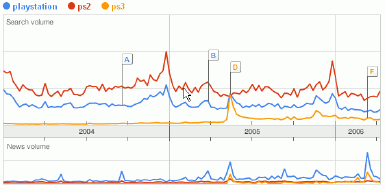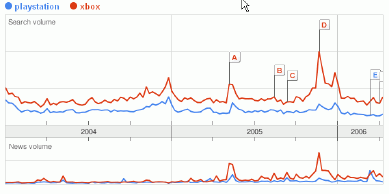I was catching up on my feed reading and noticed posts on Techcrunch and Micropersuasion about Google’s new buzz tracking product, Google Trends. According to Google:
“Google Trends analyzes a portion of Google web searches to compute how many searches have been done for the terms you enter relative to the total number of searches done on Google over time. We then show you a graph with the results — our search-volume graph.”
Basically, Google Trends is a souped up version of the trending tools that have been in place for awhile on blog search engines like IceRocket and Blogpulse. The advantage Google Trends has over those products is that it gets to use Google’s own, much more robust data set (much greater search volume, ability to tie to news articles, etc.) and piggy back on the fantastic graphs that were developed for Google Finance. Google Trends is an interesting product, but I would offer a few notes of caution as folks begin hyping the tool:
(1) One bigpotential flaw in Google Trends is that the keywords people use in searches can be unpredictable. People use Google in different ways – a keyword set that makes sense to you may not to others. The reliance on keywords is limiting, and could lead to misinterpretation of data. As an example, below are the results for a variety of ways people might look for information on Sony Playstation.

So if someone didn’t account for the different ways people might search for Playstation information and simply compared the terms Xbox to Playstation, they’d get an inaccurate trend graph. All the graph below tells you is that Xbox is a more straighforward search phrase than Playstation.

(2) The results Google Trends produces should be taken with a healthy grain of salt. As Google itself writes: “The data Google Trends produces may contain inaccuracies for a number of reasons, including data-sampling issues and a variety of approximations that Trends makes use of. We hope you find this service interesting and entertaining, but you probably don’t want to write your PhD dissertation based on this information.”
(3) Google Trends doesn’t currently update in real time. Google says they will be updating the trend data approximately once a month. To me, this takes away a lot of the tool’s utility. When looking for this type of information, I’m generally looking at things happening right now, not a month ago. As an example, below is the trend graph for Patrick Kennedy, who was all over the news last week due to his battle with addiction.
As you can see, Google Trends shows the impact of the story in news volume, but doesn’t yet show search volume data from last week. So if you are interested in up-to-date trend data, you’re out of luck at this point.
(4) I have to wonder whether Google Trends’ graph-based interface is the best approach for trend tracking. I personally like having the ability to graph keyword trends, but for most people a trend discovery approach like Yahoo Buzz is probably more compelling. Yahoo Buzz focuses on identifying hot keywords for the day, spoon feeding users hot topics by analyzing changes in search volume. What we probably need is a combination of Yahoo Buzz and Google Trends.
Sign up today to have our latest posts delivered straight to your inbox.